
How to Select the Best AI Voice API in 2025
Avalon Brooks
November 26, 2025
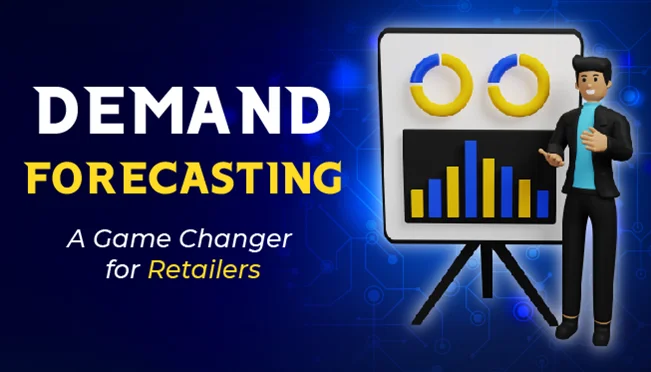
In today’s fast-paced retail environment, staying ahead of demand is important yet challenging. Traditional forecasting methods usually rely on historical data and common models, which are not enough to keep up with the modern pace. Eventually, it leads to overstocking, stockouts, and missed sales opportunities.
This might be daunting, especially for retailers, but fret not; enter AI-powered demand forecasting, a game-changing solution for e-commerce. By channeling the power of machine learning and predictive analytics, AI helps businesses forecast demand, optimize inventory, and reduce operational costs - all efficiently.
In fact, according to some resources, AI-driven demand forecasting can enhance forecasting accuracy by up to 50%. Moreover, it has also been noticed that it reduces supply chain errors by 30-50%. Are you eager to know how?
In this article, we’ll step into the realm of demand forecasting and discover how implementing AI can transform the supply chain process.
AI-enabled demand forecasting uses advanced technologies like machine learning, predictive analytics, and natural language processing (NLP) to anticipate future demand with high precision and accuracy.
Unlike traditional methods, which greatly rely on historical data, AI models frequently learn from current data, market trends, and consumer behavior patterns. This enables them to forecast demand fluctuations efficiently and effectively.
Moreover, these systems can manage complex data inputs and transform them according to evolving market conditions. Overall, it offers businesses a more dynamic approach to inventory and supply chain management.
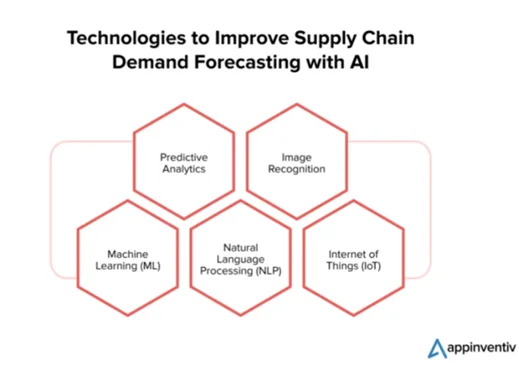
Usually, AI-based forecasting integrates the following technologies:
| Key Technologies | Description |
|---|---|
| Machine Learning | Continuously monitor vast amounts of old and real-time data to enhance the accuracy of demand predictions. |
| Predictive Analytics | Utilize statistical algorithms and data mining techniques to anticipate future results based on previous trends. |
| Natural Language Processing | Monitor customer sentiment, reviews, and social media data to analyze current market trends and consumer needs. |
| IoT & Cloud Computing | Lastly, these technologies provide real-time data from linked devices and cloud platforms, making businesses respond swiftly to demand changes. |
Overall, by incorporating these technologies, AI can provide a more precise, innovative, and scalable way to demand forecasting.
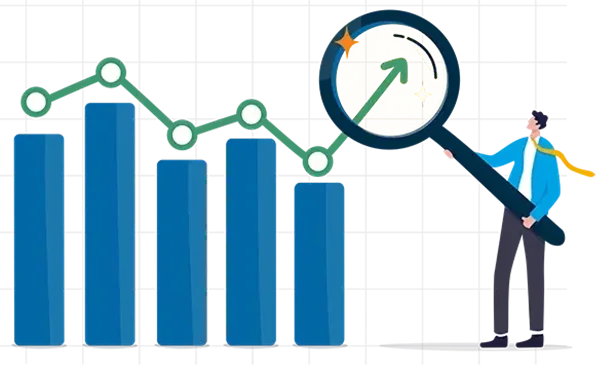
Demand forecasting has seen a significant shift in the retail industry compared to its early days. Gone were the days when we used statistical models and historical data as the main tools to predict future demands.
Moreover, the increase in online shopping has brought significant obstacles to businesses, such as struggling to predict consumer behavior and manage inventory. Notably, with advancements in AI, forecasting has become more sophisticated and powerful, enabling businesses to make accurate predictions.
Previously, as we know, traditional forecasting methods typically depended heavily on historical sales data and basic statistical models to determine demand. While these approaches worked in the past, they are not adequate to match the pace of modern e-commerce.
The drawbacks of these approaches often result in wrong predictions, leading to overstocking or stockouts. The table below discusses the challenges and impacts that occur due to traditional forecasting techniques:
| Traditional Forecasting Challenges | Impact on the Retail Industry |
|---|---|
| Fewer data sources | Inaccurate and incomplete analysis of market trends. |
| Struggle with responding to changes | Inadequate efficiency to keep up with new market shifts often results in missed sales opportunities. |
| Inability to handle complex trends | Inaccurate predictions during high demand, overstocking, or stockouts. |
AI for demand forecasting significantly changes the way businesses anticipate future demand by using advanced techniques and large data sets. We have already explored key AI technologies that are used in demand forecasting.
However, in this section, we shed light on how these technologies work to forecast demands.
Generally, AI uses large amounts of data from various sources, such as past sales data, market trends, customer demands, and social media sentiments. By analyzing and interpreting these complex insights, AI systems monitor patterns and offer more accurate demand forecasts.
For instance, the integration of real-time data allows businesses to react quickly to changing market trends and consumer requirements.
Notably, AI models deploy advanced algorithms and machine learning models to learn from new data inputs consistently. This repetitive learning process assists retailers in refining forecasts and minimizing errors over time.
For instance, machine learning allows AI systems to monitor emerging trends and adapt predictions accordingly. It also ensures that forecasts remain relevant and accurate even in fickling market conditions.
Predictive analytics plays a substantial role in AI-enabled demand forecasting. It uses statistical models and real-time data to generate dynamic and accurate forecasts. Moreover, these models predict coming demand with a high degree of certainty.
This helps businesses make informed decisions about inventory management, efficient resource allocation, and updating pricing strategies. With the ability to forecast current situations, e-commerce, retailers, and other businesses can swiftly adapt to changes in consumer demand and market trends.
Overall, it improves efficiency to a greater level.
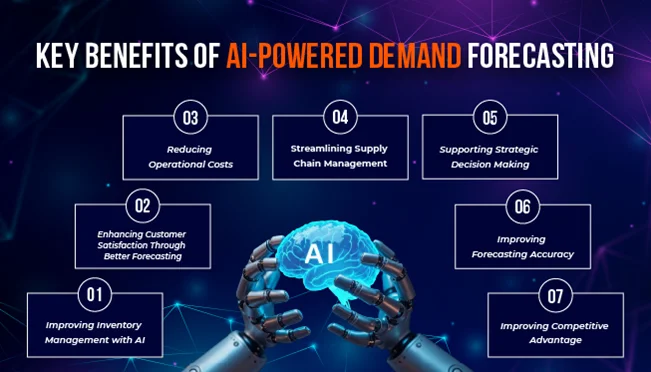
The integration of artificial intelligence in demand forecasting is, undoubtedly, an essential step in taking supply chain management to the next level. Moreover, the benefits it brings to various industries, including retail, life sciences, healthcare, manufacturing, and more, are unprecedented.
Let’s have a look at the key benefits of AI in demand forecasting in detail:
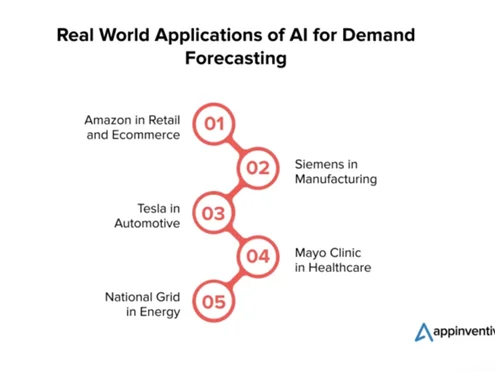
We have explored the theoretical aspects of how AI in demand forecasting is helping businesses. But at the same time, it is essential to understand its real-world use cases. Let’s explore some of its real-world applications:
Businesses in retail and e-commerce are using AI in demand forecasting for dynamic pricing and accurate demand predictions. AI-driven demand forecasting enables retailers to optimize inventory and improve customer satisfaction, giving them a critical edge in the fast-paced e-commerce market.
For example, brands like Amazon are using AI to analyze customer data and dynamic pricing strategies, ensuring competitive pricing while fulfilling customer demand.
In the manufacturing landscape, demand forecasting is helping with supply chain optimization. By analyzing customer data in real-time, AI systems optimize production schedules, planning, and resource allocation. This will allow companies to reduce waste and meet market needs quickly and efficiently.
For example, Siemen, a global manufacturing company, uses AI-enabled demand forecasting to optimize production schedules.
By reviewing data from different sources, such as market redlands, supplier performances, and previous data, it adjusts its production process, staying ahead in demand fluctuations and increasing overall operational efficiency.
The healthcare sector benefits from AI demand forecasting by improving patient care and operational efficiency, ensuring timely resource availability, and streamlining staffing schedules. Moreover, it assists medical professionals in adapting efficiently to patient needs and supply chain challenges.
For example, Mayo Clinic deploys AI to forecast patient visits precisely, which helps them with efficient resource allocation and staffing needs.
Moreover, this predictive ability enables the clinic to maintain the utmost standards of patient care by ensuring that necessary medical supplies and staff are readily available.
The next industry where AI demand forecasting is making waves is automotive. In this sector, it helps optimize operations from manufacturing to aftermarket services. Moreover, it also ensures optimal inventory management and improves customer satisfaction through effective resource management.
For example, Tesla, a trailblazer electric vehicle (EV) manufacturer, encounter a market shift with unpredictable demand for various car models.
To overcome this challenge, Tesla utilizes an AI-driven demand prediction model for its vehicles, streamlining production schedules and imprint production efficiently and making sure to address customer demands in a timely manner.
The last sector on our list where AI demand forecasting is booming is the energy and power industry. The demand prediction enables the energy industry to manage supply and demand efficiently.
It uplifts grid reliability and supports the integration of renewable energy resources. Overall, it leads to a more efficient, sustainable, and stable energy supply.
For example, National Grid implements AI to detect historical data and real-time information to predict energy demand and supply.
This predictive functionality improves grid reliability by managing resource allocation and increasing operational stability to ensure a sustainable and effective energy distribution network.
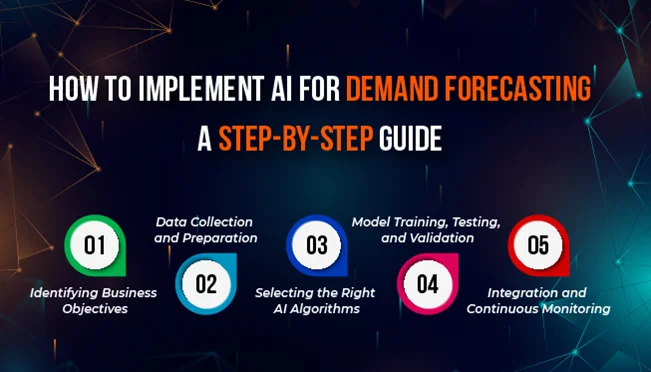
Whether you are a retailer or belong to any other industry, we can’t overlook the fact that implementing AI for demand forecasting is essential for every business. By following the below steps, you can successfully utilize AI for demand forecasting.
It all starts by defining clear objectives for implementing AI in demand forecasting. You must have a clear vision of why you need demand prediction. Whether you want it to reduce stockouts, optimize inventory levels, improve customer satisfaction, or enhance overall operational efficiency.
Aligning AI solutions with these objectives helps you focus on effective implementation.
The next step is gathering insights and high-quality data from multiple sources, such as sales history, market trends, customer behavior, and supply chain metrics. After gaining the data, refine it to mitigate any inaccuracies and ensure that it is all set for training AI models.
High-quality, reliable data serves as the basis of accurate demand forecasts.
Now, you need to choose algorithms that best fit your business goals, such as machine learning for pattern recognition or natural language processing for monitoring unstructured data.
Selecting the right models enables you to tailor solutions to your prediction requirements.
Once you choose suitable AI models, the next step is to train them using historical data to analyze patterns and make predictions. After training, text and validate the model to determine its accuracy and reliability.
In short, iterative testing allows you to fine-tune the model and reduce errors in demand forecasting.
Now, it's time to integrate AI models seamlessly into your existing workflows, such as supply chain management or inventory tools. Once the integration is done, make sure to keep a keen eye on model performance by continuously monitoring it.
If necessary, adapt to new data and make essential changes to maintain accuracy and effectiveness over time.
While implementing AI for demand forecasting, there are some key considerations that need to be addressed and viewed carefully. Let’s explore each one by one.
After reading the above points, it is crystal clear that the future of AI-powered demand forecasting, not only in retail but in every industry, is likely to boom. Some future trends that we can expect in coming years are discussed below:
Advancements in AI are never going to stop in the near future. Emerging technologies such as generative AI, advanced machine learning, and IoT integration will further improve accurate demand forecasting.
Additionally, retailers will adopt AI-driven tools to manage complex data environments and offer real-time information.
In the next few years, AI will enable hyper-personalized forecasting, adjusting inventory and product availability according to each individual's preferences.
This level of accuracy will reshape customer experience and increase loyalty in competitive markets.
Additionally, we anticipate that the adoption of predictive analytics will expand in the future. This will allow retailers to oversee shifts in demand due to external factors such as economic shifts, seasonal trends, or global events.
Eventually, this proactive approach will assist businesses to stay resilient.
Seeing the current growth of AI models, we expect them to evolve further to address limitations like data integration complexities and transparency concerns. Moreover, innovations in explainable AI and seamless integration will streamline adoption and operational performance.
AI will play a prominent role in promoting sustainable real practices. By reducing waste through more efficient demand forecasting, it will mark a new era.
Furthermore, optimized inventory management will assist retailers in reducing overproduction and massive inventory, adding to eco-friendly operations.
In the coming years, AI-powered forecasting will shift from a competitive advantage to a business need. In short, retailers that invest in these technologies will remain competitive and agile and excel in an increasingly data-driven landscape.
In conclusion, AI-enables demand forecasting is transforming the retail landscape with unmatchable accuracy, efficiency, and competitiveness.
By using advanced technologies like machine learning, predictive analytics, and NLP, businesses can foresee customer needs, optimize inventory, and improve operational efficiencies.
Our AIChief team researches AI in demand forecasting thoroughly and gives you a comprehensive overview of its applications, benefits, and implications.
In a nutshell, this revolutionized approach not only reduces operational costs and enhances customer satisfaction but also allows retailers to navigate the complexities of the modern market.
We believe that adopting AI-powered forecasting is no longer an option for retailers; it is a necessity for staying ahead of the competitive retail landscape.
Unsurprisingly, traditional methods fail to capture seasonal variations and dynamic market shifts as they highly rely on simple predictive models. On the other hand, AI-powered solutions powerfully analyze real-time data and suggest adaptive solutions, making accurate predictions and correlations.
Yes, for sure. Small businesses can highly benefit from AI-driven supply chains and demand forecasting through cost-effective, cloud-based solutions that give scalable options tailored to their needs.
Businesses can implement AI solutions with current workflows by using APIs, cloud-based platforms, and collaborative cross-departmental strategies to ensure seamless supply chain operations.